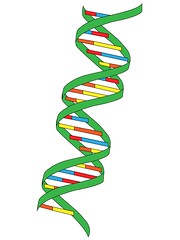| 9301295289 | DNA | This is short for Deoxiribonucleid Acid. It is a long, thin, double stranded, helical, molecule that contains all the instructions to make all the proteins in our bodies. It remains in the nucleus of our cells at all times. It is hereditary material, which means that it is passed on from cell to cell, and from parents to offspring. |  | 0 |
| 9301295290 | RNA | This is short for Ribonucleic Acid. It is a single stranded long molecule that contains information transcribed from DNA to make proteins. It is made in the nucleus but it is released into the cytoplasm of the cell where it can be translated into proteins. |  | 1 |
| 9301295291 | Purines | This is the name of nitrogen bases with two rings in nucleotides of DNA. The two are Guanine (G) and Adenine (A). |  | 2 |
| 9301295292 | Pyrimidines | This is the name of the nitrogen bases with one ring in nucleotides of DNA. The two are Cytocine (C) and Thymine (T). In RNA, there is Uracil (U) instead of Thymine (T). |  | 3 |
| 9301295293 | Nucleotides | This is the name of the smaller molecules (monomers) that combine to make DNA. |  | 4 |
| 9301295294 | Genes / Exons | This is a piece of DNA with instructions to make one protein. This is transcribed into RNA which exits the nucleus to be translated into protein molecules in the cytoplasm. |  | 5 |
| 9301295295 | Introns | This is a piece of DNA with no instructions to make anything. It remains inside the nucleus at all times. |  | 6 |
| 9301295296 | Anti-parallel | This is a description of the orientation of the two backbones of DNA (strands). Each phosphate and sugar in the backbone connects in the same way (3' to 5') but the two backbones point in opposite directions. |  | 7 |
| 9301295297 | Chromosome | This is the organization of DNA during cell division. It is very tightly coiled to prevent it from getting tangled up. However, it doesn't stay in this form because DNA cannot be used unless it is uncoiled. (Analogy: Headphones and shoe laces have to be coiled to keep from tangling, but they have to be uncoiled to be used.) |  | 8 |
| 9301295298 | DNA Backbone | This is the part of the DNA molecule made from bonded sugars and phosphate groups into long chains. It is bonded with strong covalent bonds so that they are stable and resist possible breakdown. |  | 9 |
| 9301295299 | Deoxiribose Sugar | This is one part of the nucleotides in DNA found between the phosphate group and the nitrogen base. This is what DNA is named after. It also forms part of the backbone of DNA. |  | 10 |
| 9301295300 | Ribose Sugar | This is one part of the nucleotides in RNA found between the phosphate group and the nitrogen base. This is what RNA is named after. |  | 11 |
| 9301295301 | Double Helix | This is the shape of DNA. It is two long strands of nucleotides twisted around each other like a spiral staircase. |  | 12 |
| 9301295302 | Nitrogen Base | This is the part of the nucleotides of DNA and RNA that gives the nucleotides their name. It can be Adenine, Thymine, Cytosine, and Guanine (A T C G) for DNA. For RNA, Uracil is present instead of Thymine (A U C G). |  | 13 |
| 9301295303 | Histones | This is a protein that DNA coils around to form Chromatin. |  | 14 |
| 9301295304 | Phosphate Group | This is the part of the nucleotide of DNA and RNA that is always the same. It has a negative charge and it part of the backbone of DNA. |  | 15 |
| 9301295305 | Chromatin | This is the name given to DNA when it is wrapped around histones (proteins) and in the shape of long threads. It is only part of the way to becoming a chromosome. |  | 16 |
| 9301295306 | Base Pairing Rules | 1. A purine always bonds with a pyrimidine to keep the distance across the DNA constant (3 rings). 2. Adenine double bonds with Thymine 3. Cytosine triple bonds with Guanine 4. No other combinations are possible |  | 17 |
| 9301295307 | Plasmid | This is the common form of DNA in eukaryotic cells (bacteria). It is a circular piece of DNA of various sizes. |  | 18 |
| 9301295308 | Hydrogen Bonds | This is the kind of bonding that connects the bases of DNA nucleotides. It is a weak bond, so it allows the DNA molecule to be uncoiled and the two strands to be separated so DNA can be read for replication or for transcription. |  | 19 |
AP Biology DNA Flashcards
Primary tabs
Need Help?
We hope your visit has been a productive one. If you're having any problems, or would like to give some feedback, we'd love to hear from you.
For general help, questions, and suggestions, try our dedicated support forums.
If you need to contact the Course-Notes.Org web experience team, please use our contact form.
Need Notes?
While we strive to provide the most comprehensive notes for as many high school textbooks as possible, there are certainly going to be some that we miss. Drop us a note and let us know which textbooks you need. Be sure to include which edition of the textbook you are using! If we see enough demand, we'll do whatever we can to get those notes up on the site for you!

